Pollen's no friend of the allergy-prone, but there's an upside to those itchy eyes — weird and colorful coronas around the Moon and Sun.
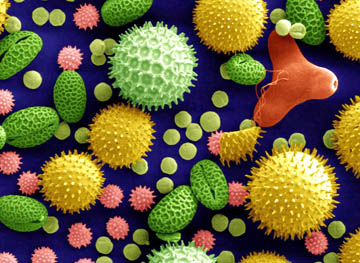
Dartmouth Electron Microscope Facility, Dartmouth College / Wikipedia / Public Domain
Gesundheit! I hear that a lot each spring when my co-workers wish me good health every time I sneeze. But it's no virus that tickles this nose and the noses of my fellow hay fever sufferers. It's pollen. Spring and fall are the traditional peaks of the pollen season, when countless flowers and coniferous cones get down to the business of propagating the species and torturing our sinuses.
Pollen grains range in size from about 0.01–0.1 mm; their tiny size lets them fly with the wind to reach destinations near and far, including our itchy eyes. I've seen puddles and ponds covered in the bright yellow scum of pine pollen.
One of pollen's lesser known and less irritating effects is the ability to scatter light the same way tiny water droplets do, creating colored rings of light around the Moon and Sun called coronas.
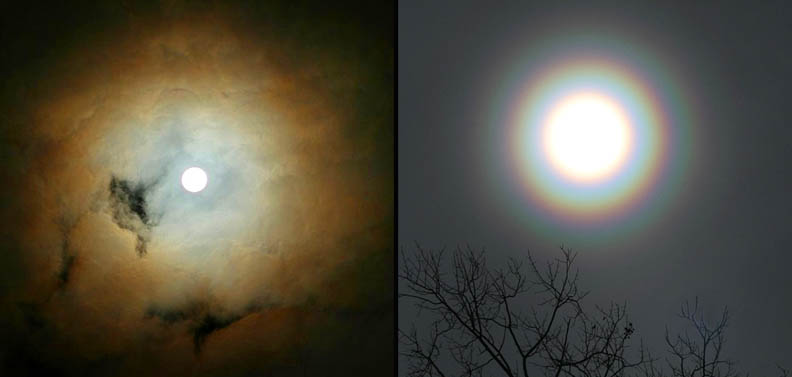
Bob King
Coronas resemble the 22° radius halos we often see centered on the Moon or Sun, but they're much smaller, typically only a few degrees in diameter, and look like small disks or a series of compact, concentric, multi-colored rings. They form by diffraction, where light waves bend and spread out as they pass through a gap similar in size to the wavelength. Diffraction also occurs when light scatters off the surface of minute objects like cloud droplets ... and pollen.

Lookangmany / CC BY-SA3.0
As the light emerges from the tiny opening (or after scattering), it spreads into waves that overlap and interfere with one another to form a ripple-like pattern of bright and dark fringes. Where the waves reinforce one another, a bright ring or fringe forms; where they cancel one another, a dark fringe or lack of light results.
The position of each fringe depends upon the light's wavelength or color. Red has the longest wavelength of visible light, so it's bent more and forms the outer fringe, while blue rays are bent the least and form the innermost fringe.
In clouds, light treats the minute water droplets as obstacles to get around and go between. Rays emerging from them spread out and overlap to create multiple fringes — sorted according to color — that look like chromatic bullseyes around the Sun or Moon.
In simple coronas, called aureoles, the Moon is centered in a pale blue inner disk fringed in red (see photo above), but when the droplets are small and of nearly identical size, the diffraction effect is enhanced, producing multiple rings of intense color. If you make a habit of checking the Moon on nights when rafts of thin, mid-level altocumulus and altostratus clouds are sliding by, you'll soon spot one of these. Like me, you'll instinctively reach for your camera!

Left: University of Illinois WW2010 Project. Right: Les Cowley / Atmospheric Optics
Light isn't fussy when it comes to obstacles. Transparent or opaque, as long as they're tiny, they'll do. That's where pollen comes into play. What makes you itch and cuss has a bright side. Light bends around the edges of the grains and interferes with itself to produce some of the most curious coronas you'll ever sneeze at. The best time to see one is when the Moon is big and bright, making for a brighter corona than those sparked by the crescent or half Moon.
Now through mid-month will be an ideal time to be on the lookout: not only will be the Moon be in the right phase (full Moon is May 10th), but trees, grass, and flowers will oblige with a bounty of pollen. You can watch through the end June whenever the Moon sports a gibbous or full phase, and resume your vigil in the fall when ragweed takes over.
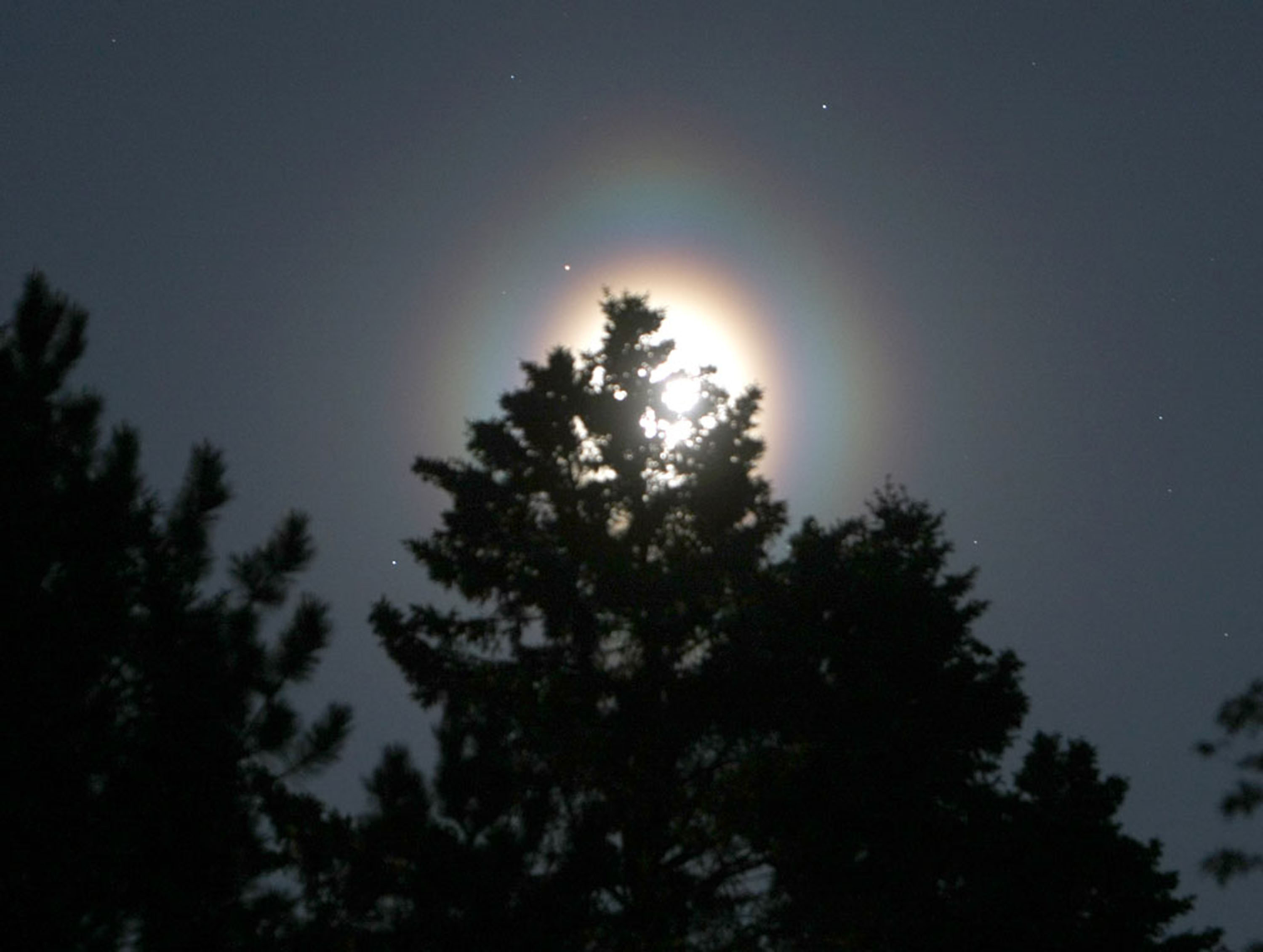
Bob King
Since pollen grains are generally larger than the supercooled droplets in clouds, they make smaller coronas. Also, unlike water droplets, their non-spherical shapes create elongated coronas often accompanied by bright patches, top and bottom, right and left of the Moon.
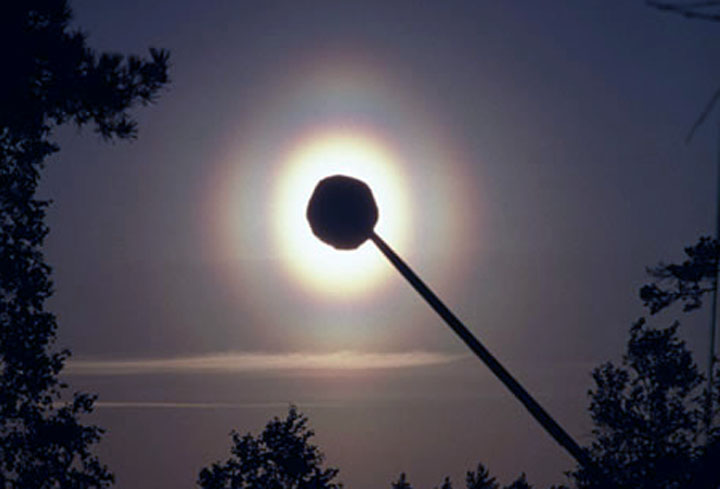
Marko Riikonen
As you might guess, coronas also appear around the Sun, but the glare can be intense. Take precaution to block the Sun with your hand or a power pole, and look for a small, multi-ringed, tinted oval of light surrounding it. For the Moon, a cloudless sky is a must. Even a thin film of high clouds will create a glowing disk around the Moon that can be mistaken for a pollen corona.
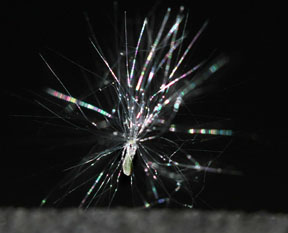
Bob King
If I suspect one of these sneezy circles, I cover the Moon with a tree top, peak of a roof, or a power pole to block the glare, so I can better discern its subtle oval or geometrical shape. If I'm still in doubt, I'll take a few quick time exposures with the camera. Pollen is usually heavier in dry, windy weather and low during rainy times. Check Pollen.com for a forecast for your city.
Diffraction occurs whenever light tries to bend around or between obstacles. You see it looking at the Sun or Moon through a fogged windowpane, in the light reflecting off the closely-spaced grooves of a CD or DVD, through hair, and off feathers. It even causes the rainbow sheen on deli meat where light is diffracted by the closely-packed tips of muscle fibers on cleanly-cut slices of beef!
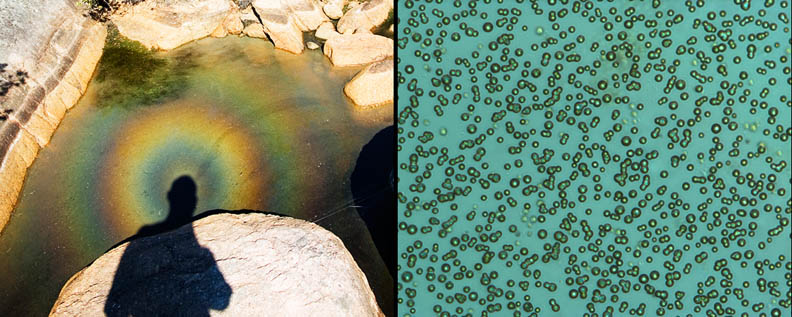
Marko Riikonen
Speaking of exotic diffraction, have you ever heard of a pond corona? I hadn't until recently, and now it's no. 1 on my list of things to look for this summer. Carpets of algae cells on a pond's surface can also scatter and diffract light to create coronas that resemble those produced by pollen. Even bacteria can get into the act, transforming lowly pond scum into the sublime.
Light does its wavy thing, whether streaming from distant quasars into the telescope eyepiece or translated by living things into vivid displays of color. Is this world amazing or what?
 1
1








Comments
Anthony Barreiro
May 5, 2017 at 6:30 pm
Yes, it is an amazing world, and there are more amazing things in it than I could ever imagine. Thanks for telling me about a couple more.
You must be logged in to post a comment.
You must be logged in to post a comment.